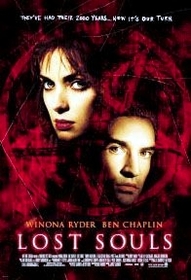Our editor-in-chief Nate Yapp is proud to have contributed to the new book Hidden Horror: A Celebration of 101 Underrated and Overlooked Fright Flicks, edited by Aaron Christensen. Another contributors include Anthony Timpone, B.J. Colangelo, Dave Alexander, Classic-Horror.com's own Robert C. Ring and John W. Bowen. Pick up a copy today from Amazon.com!
Lost Souls (2000)
Lost Souls is yet another film about demonic possession, the arrival of Satan on Earth in human form and a grand battle (at least spiritually, not special effects-wise) between good and evil. How many films have we seen about that subject matter? 250?
The "problem" is that it doesn't matter how many films we've seen about that subject matter-this is a damned good work of art. Even if the script wasn't excellent, and it is, even if the direction wasn't impeccable, and it is, you'd have to go see this film just for the amazing, breathtaking cinematography of Mauro Fiore.
It shouldn't be a surprise that the cinematography is so good perhaps, because first time director Janusz Kaminski is an experienced cinematographer with four of Spielberg's best films under his belt. Surely much of the lens work in Lost Souls is attributable to Kaminski's presence in one way or another.
One unusual, beautiful aspect of Fiore's work here is that almost every scene is realized with a washed-out, beige-green tint. It gives Lost Souls an effect that vacillates between black and white, creepy sepia tones, and at times, resembles the unusual tinting featured in classic silent genre films such as The Cabinet of Dr. Caligari or Les Vampires. However you describe it, the effect is, well, supernatural and dark-exactly what Lost Souls needs.
But what about the story? Winona Ryder is Maya Larkin, a Catholic Schoolteacher. She has an unusual past (which we see non-sequentially through a great, quick flashback), as she was possessed as a teen. She has an equally unusual present, surely spurred on by her past, as the only secular member of a team not only performing exorcisms on "vanilla" cases, but also searching for the human who Satan is destined to take over.
At a particularly nasty exorcism of a professor who murdered his family after his demonic fruition, Maya snatches the professor's handwritten notes from his room in a psychiatric prison. They're written in a cryptographic numbering system. When Maya cracks the system, she discovers that they reference Peter Kelson, a famous author. Is Kelson the person fated to become the Antichrist?
Kaminski and screenwriter Pierce Gardner (apparently Kaminski had a hand in rewrites) make very little of this literal. One of the triumphs of this film's script is that not much is telegraphed; Kaminski wants the audience to think.
He also wants to leave much of Lost Souls ambiguous. Not only is this apparent in the ingenious ending (although, I must say that a large percentage of the crowd I saw the film with seemed disappointed with the ending, but then again, the theater where I usually catch new films at doesn't attract audiences who want to think much about ambiguous elements), but most of Lost Souls works equally well as a psychological horror film as a supernatural thriller. Both aspects are just as strong, so either reading is forced into a profound gray area-just like the tinting of the cinematography.
Frankly, I thought the ending was one of the best things about the film, and in its way it is as profoundly anti-climatic, and contrary to what audiences want, as say, the ending of Night of the Living Dead. Despite the crowd reaction, I thought the ending was perfect, and as soon as the last shot began, I said to myself, "it would be exquisite if it just ended here," half dreading that we'd get a stereotypical effects extravaganza instead.
Kaminski has stated that this ambiguity is one of the primary things he tried to achieve. In Fangoria (#197, October 2000, page 31) he said, "I grew up on American films and I remember that there were things that were not always explained. Now you're not supposed to do that because the audience has to be satisfied . . . It's destructive, and makes for mediocrity because audiences now go to movies and don't have to think."
Kaminski's direction is remarkable, and in addition to telling a tight story, many ancillary images will stick in your mind-all of them integral to the overall arc. For instance, a weighty sequence of priests "marching" in to perform the film's last exorcism-it isn't overdone, and we only see the bottom part of their legs, but the attitude the segment conveys is as intense as Neo heading into the office building near the end of The Matrix.
Yes, there are many superficial similarities between Lost Souls and The Exorcist. We even have an important medallion, fighting dogs, and of course, the possession scenes. But Kaminski realizes them all in a truly unique way that, for my money, easily trumps Friedkin's work for both its impact on the story and its artistic merit. Whereas some of these elements were more poetic, disengaged totems in The Exorcist, in Lost Souls they serve to further our joyous dark descent into the events that the characters are wrapped in.
Lost Souls certainly never rips material from any other film of similar subject matter. As the premise is an important myth in Judeo-Christian cultures, there will be necessary likenesses. Kaminski obviously knew this, anticipated possible criticisms, and went to great and successful pains to ensure that Lost Souls incorporates the necessary stereotypes in a novel, moving way.
With incredible performances, a fascinating story, an intelligent script, and all the other extraordinary elements that comprise Kaminski's pithy finished product, Lost Souls is an exemplary work of psychological/supernatural horror fiction with a strong character base. Let's hope we see much more from this director in the future.








